Helpful Guides on each Category
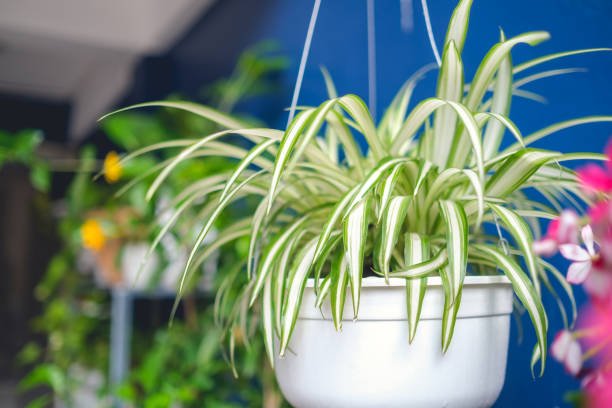
Spider plant, also known as Chlorophytum comosum, is a flowering plant popular as houseplant due to its easy care and striking appearance.
Originating in South Africa, spider plants have become popular all over the world due to their ability to adapt to a wide range of conditions.
Spider plants are also commonly known as the airplane plant, ribbon plants, or spider ivy.
They are part of the Asparagaceae family, which includes other popular houseplants such as the snake plant and the dracaena.
Spider plants are known for their long, thin leaves that can grow up to two feet in length.
They are also great for purifying the air in your home.
They are known to remove harmful toxins such as formaldehyde and xylene from the air, making them a great choice for anyone looking to improve their indoor air quality. Airplane Plants are a wonderful choice for anyone looking for an easy-to-care-for and visually striking houseplant.
Quick tabular Overview of spider plants
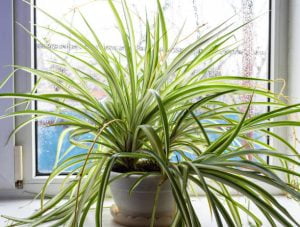
| Scientific Name | Chlorophytum comosum |
| Common Name | Spider Plant, Airplane Plant, Ribbon Plant, Spider Ivy |
| Family | Asparagaceae |
| Origin | South Africa |
| Growth Rate | Moderate |
| Size | Can grow up to 2 feet long and 2 feet wide |
| Bloom Time | Summer to Fall |
| Required Lighting | Bright, indirect light |
| Required Soil Type | Well-draining soil |
| Temperature | 60-75°F (15-24°C) |
| Fertilizer | Balanced fertilizer every 2-3 weeks during growing season |
| Toxicity | Non-toxic to humans and pets |
| Plant Combination | Spider plants can be combined with other low-light, easy-care plants such as snake plants and pothos |
| Diseases | Root rot |
| Balanced fertilizer every 2-3 weeks during the growing season | Spider mites, mealybugs, and scale insects can infest spider plants. |
Spider plant Description
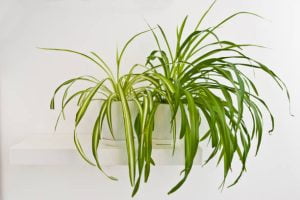
Spider plants have long, thin leaves that can grow up to two feet in length. The leaves are often variegated, with white or yellow stripes running down the centre of the leaf.
The leaves grow from the centre of the plant, which is a rosette of tightly packed leaves that resemble a spider web, hence the name “spider plant”.
In addition to their leaves, spider plants also produce small, white flowers that bloom in the summer and fall. These flowers can add an extra burst of colour to your home, and can even produce small plantlets that can be propagated to grow new spider ivy.
One of the unique features of Airplane Plants is their ability to propagate themselves. As mentioned, the flowers can produce small plantlets that grow on long stems.
These plantlets can be easily propagated by cutting the stem and placing it in water or soil. The plantlets will develop roots and can be planted in their pots to grow into new ribbon plants.
spider plant benefits
Spider plants are not just beautiful additions to your home decor – they also have great benefits for both you and your indoor space.
Here are some of the key benefits of spider plants:
- Air purifying: Spider plants are known for their ability to purify the air in your home. They can remove harmful toxins such as formaldehyde and benzene from the air, making your living space cleaner and healthier.
- Natural humidifier: Spider plants release moisture into the air, acting as a natural humidifier. This can be especially beneficial in dry indoor environments, helping to keep your skin and respiratory system healthy.
- Aesthetic appeal: Spider plants have long, flowing leaves that add a touch of natural beauty to any room. They come in a range of colours, from green to variegated, so you can choose a plant that complements your decor.
- Propagation: Spider plants are prolific growers and produce many plantlets or “babies” that can be propagated to create new plants. This makes them an excellent choice for those who want to expand their plant collection without having to purchase new plants.
How to Care for a spider plant
Spider Ivy is a popular and easy-to-care-for houseplant, but like any plant, they do require some attention and care to keep them healthy and thriving.
In this section, we’ll cover the basics of spider plant care, including their light requirements, temperature and humidity preferences, soil requirements, fertilizer needs, and pruning and grooming tips.
A. Spider plant light requirements
Spider plants prefer bright, indirect light. They can tolerate some direct sunlight, but too much can scorch their leaves. Place your spider plant near a north or east-facing window, or in a spot where it will receive filtered light. If your spider plant isn’t getting enough light, its leaves may become pale or yellow.
B. Temperature and humidity
Spider plants prefer temperatures between 60 and 75°F (15-24°C).
They can tolerate temperatures as low as 40°F (4°C) and as high as 90°F (32°C), but extreme temperatures can stress the plant. Spider plants prefer moderate humidity, so consider placing a humidifier near your plant, or misting it with water to keep the air around it moist.
C. Soil requirements. What kind of soil do spider plants like?
Spider plants prefer well-draining, slightly acidic soil. Use a quality potting mix that contains peat moss or perlite to improve drainage. Avoid using heavy soils that retain water, as this can lead to root rot.
D. What fertilizer for spider plants?
Spider plants don’t require a lot of fertilizer, but they will benefit from a balanced, water-soluble fertilizer every 2-3 weeks during the growing season (spring and summer). Dilute the fertilizer to half-strength to avoid over-fertilization, which can burn the roots and leaves.
E. Pruning and grooming Need
Spider plants can grow quite large and bushy if left unchecked, so regular pruning is necessary to keep them looking their best. Remove any yellow or dead leaves as soon as you notice them, and trim back any stems that are growing too long or straggly. You can also remove the small plantlets that grow from the stems and propagate them to create new spider plants.
In addition to pruning, grooming your spider plant can help it look its best. Wipe the leaves with a damp cloth to remove any dust or debris, and trim back any brown or damaged leaf tips with a pair of sharp scissors. Grooming your spider plant regularly will help it stay healthy and vibrant.
How to propagate spider Ivy
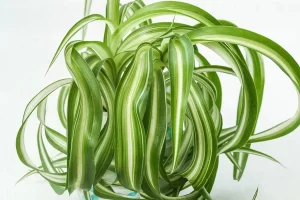
Spider Ivy is easy to propagate and makes great gifts for friends or family members. In this guide, we’ll cover the basics of spider plant propagation, including an overview of the process, different propagation methods, and a step-by-step guide for each method.
Spider plants can be propagated in several ways, including division, runners, and plantlets.
All of these methods involve separating a part of the existing plant and planting it in its pot to grow into a new plant.
Division way of propagating spider plant
This method involves separating the root ball of the spider plant into two or more sections, each with its own set of leaves and stems.
To grow new spider plants using the division method, follow these steps;
- Step 1: Choose a healthy spider plant and gently remove it from its pot.
- Step 2: Separate the root ball into two or more sections, making sure each section has its own set of leaves and stems.
- Step 3: Plant each section in its own pot, using a well-draining potting mix.
- Step 4: Water the newly planted sections thoroughly and place them in a bright, indirect light.
How to propagate Spider Ivy with Runners
Spider plants produce long, thin stems called runners that grow out from the base of the plant. These runners can be cut off and planted in their own pot to grow into a new plant.
Here’s how to grow new spider plants with the runners;
- Step 1: Choose a healthy spider plant and locate the runners growing from the base of the plant.
- Step 2: Using a clean, sharp pair of scissors or pruning shears, cut the runner off the parent plant.
- Step 3: Plant the runner in its own pot, using a well-draining potting mix.
- Step 4: Water the newly planted runner thoroughly and place it in a bright, indirect light.
Propagating Spider Plants from Plantlets/ Babies.
Spider plants also produce small plantlets at the ends of their stems.
These plantlets can be left attached to the parent plant until they develop their roots and then planted in their own pot.
Below is a detailed guide to propagating new plants from plantlets;
- Step 1: Locate the small plantlets growing at the end of the spider plant stems.
- Step 2: Allow the plantlets to develop roots while still attached to the parent plant.
- Step 3: Once the plantlets have developed their roots, gently separate them from the parent plant.
- Step 4: Plant the plantlets in their own pot, using a well-draining potting mix.
- Step 5: Water the newly planted plantlets thoroughly and place them in a bright, indirect light.
With these simple steps, you can propagate spider plants and enjoy their lush, green foliage in multiple locations throughout your home or share them with your friends and family.
Watering Requirements for Airplane Plants
They are known for their hardiness and ability to withstand drought conditions. However, it is still important to water them correctly to keep them healthy and thriving.
Here’s what you need to know about spider plant watering requirements:
How often do I water my Ribbon plants
Ribbon plants should be watered sparingly, allowing the soil to dry out between waterings. In general, you should water your plant once every two to three weeks during the growing season (spring and summer) and once a month during the dormant season (fall and winter).
Best practices for watering Ribbon Plant
When watering your spider ivy plant, it’s important to follow these best practices:
- Use a well-draining potting mix to prevent water from sitting in the soil.
- Water at the base of the plant rather than on the leaves to prevent rot.
- Allow the soil to dry out completely between waterings.
- Avoid letting the plant sit in standing water, as this can lead to root rot.
Signs of over-watering or under-watering
Over-watering: If your ribbon plant is overwatered, you may notice yellowing or browning leaves, soft or mushy roots, and a foul odour coming from the soil.
Under-watering: If your ribbon plant is underwatered, you may notice dry, crispy leaves and a wilted appearance.
Solutions to common Spider Ivy watering Problems
1. Root rot:
If you notice that your spider ivy plant’s leaves are turning yellow and mushy or that the plant is drooping, it may be suffering from root rot.
To fix this issue, you’ll need to remove the plant from its pot, trim away any rotting roots, and repot the plant in fresh, well-draining soil.
2. Wilting:
If your plant is wilting, it may be a sign that it’s not getting enough water. Try watering the plant more frequently and make sure that the soil is moist but not waterlogged.
3. Leaf discolouration:
If the leaves of your plant are turning brown or yellow, it may be a sign that the plant is getting too much water. Scale back on watering and allow the soil to dry out before watering again.
4. Brown tips:
Brown tips on the leaves are usually a sign of dry air or underwatering.
Common Pests and Diseases with Solutions
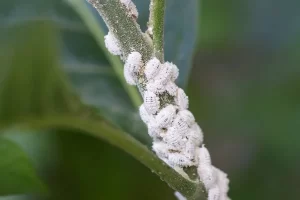
Ribbon Plant Pests
1. Spider mites:
These tiny pests can cause yellowing and browning of the leaves.
2. Mealybugs:
These small, white insects can leave a white, powdery substance on the leaves.
3. Scale insects:
These pests can cause yellowing and browning of the leaves, as well as stunted growth.
Diseases of Spider Plant
1. Root rot:
Overwatering or poor drainage can cause the roots to rot, leading to wilting and discolouration of the leaves.
Solutions to Pests and Diseases of Spider Plant
- Spider mites: Wipe down the leaves with a damp cloth and treat them with insecticidal soap or neem oil.
- Mealybugs: Remove any affected leaves and treat them with insecticidal soap or neem oil.
- Scale insects: Use a cotton swab dipped in rubbing alcohol to remove the insects and treat them with insecticidal soap or neem oil.
- Root rot: Remove the plant from its pot, trim away any rotting roots, and repot in fresh, well-draining soil.
- Brown tips: Increase the humidity around the plant and make sure it’s getting enough water.
- Yellowing leaves: Adjust your watering schedule and check for pests. If necessary, treat with insecticidal soap or neem oil.
Are spider plants Toxic to cats & other Pets?
Spider plants (Chlorophytum comosum) are generally considered non-toxic to cats and dogs. This means that if your pets accidentally snacks on some of the plant, they should not need an urgent call from the doctor.
spider plant babies.
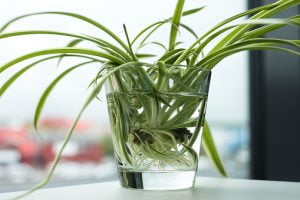
Spider plant babies, also known as spiderettes or plantlets, are small offshoots that grow from the main plant. These babies are easy to care for and can be propagated to create new spider plants.
They typically appear on long, arching stems that extend from the main plant. The babies are small and initially have only a few leaves, but they will grow quickly with proper care.
To propagate spider plant babies, simply cut the stem that holds the baby and place it in water or potting soil. If using water, make sure the bottom of the stem is submerged but the leaves are not. Change the water every few days to prevent bacterial growth.
Alternatively, you can plant the spider plant baby directly in the soil. Make sure the soil is well-draining and keep it moist but not waterlogged. The baby should take root and begin growing within a few weeks.
Spider plant babies can also be left to grow on the main plant, creating a fuller and more lush appearance.
How long does it take for spider plants to produce babies?
Spider plants are known for their ability to produce babies relatively quickly. In ideal growing conditions, spider plants can start producing babies as early as six months after they are planted.
However, the timing of baby production can vary based on a number of factors, such as the age of the plant, the amount of light and water it receives, and the temperature and humidity levels in its environment.
Once the babies have formed, they will continue to grow and develop for several weeks to several months before they are large enough to be propagated and grown into new plants.
Should I cut the babies off my spider plant? When
Whether or not to cut the babies off your spider plant depends on your personal preference and the overall health and appearance of your plant.
If you want your spider plant to maintain a more compact shape, it’s a good idea to remove some of the babies as they grow. Over time, spider plants can become overcrowded and produce fewer babies, so removing some of them can help to encourage new growth.
To remove a spider plant baby, simply cut the stem that holds the baby and either propagate it or discard it.
However, if you want your spider plant to have a fuller, more lush appearance, you can leave the babies on the plant. As the babies grow, they will create a fuller and more vibrant display of foliage.
In general, it’s best to wait until the babies are a few inches long and have developed several leaves before removing them. This will ensure that they have enough energy and nutrients to survive and thrive on their own.
Can I put spider plant babies in water?
Yes, spider plant babies can be propagated in water. In fact, propagating spider plant babies in water is a popular and easy way to grow new plants. Although this is not the best method for long-term growth. Spider plants prefer well-draining soil and can become waterlogged if left in water for too long.
To propagate spider plant babies in water, simply cut the stem that holds the baby and place it in a jar or vase filled with water. Make sure that the bottom of the stem is submerged in the water, but the leaves are above the water line.
Over time, the baby will begin to grow roots in the water. Once the roots are a few inches long, you can transfer the baby to a pot filled with soil and continue to grow it as a new plant.
Do spider plants have flowers?
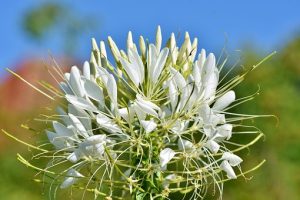
Yes, spider plants can produce flowers, although it’s not common for them to do so when they are grown indoors.
When spider plants produce flowers, they typically appear as small, white or yellow blooms on long stems that extend above the foliage. The flowers can add a lovely touch of colour and fragrance to the plant and are often followed by small, berry-like seed pods.
It’s worth noting, however, that some indoor spider plants may never produce flowers, particularly if they are not given the proper growing conditions. Spider plants prefer bright, indirect sunlight, well-draining soil, and regular watering to encourage healthy growth and flowering.
If you want to encourage your spider plant to produce flowers, make sure it’s getting enough light and nutrients, and keep it in a well-draining potting mix.
How can you tell the difference between a male and female spider plant?
Spider plants do not have distinct male and female plants like some other species. Instead, spider plants are hermaphroditic, meaning they have both male and female reproductive structures on the same plant.
When spider plants produce flowers, they will have both male and female parts present. The male parts of the flower produce pollen, while the female parts contain ovules that can be fertilized by the pollen.
FAQs on Spider Plants
In some Native American cultures, spider plants are associated with creativity and artistic expression. The long, flowing leaves of the spider plant are thought to represent the interconnectedness of all things, and their ability to grow and propagate easily is seen as a metaphor for the growth and expansion of ideas and creativity.
In Feng Shui, a Chinese philosophical system that seeks to harmonize people with their environment, spider plants are believed to bring positive energy or “Chi” into a space. They are thought to represent abundance and prosperity, and placing them in the wealth or abundance corner of a room is said to enhance these qualities.
In addition to their association with good luck, spider plants are also believed to have other positive qualities.
Yes, tap water is generally safe for spider plants. However, the quality of tap water can vary depending on the location, and certain minerals or chemicals in the water can build up in the soil over time and cause problems for the plant.
If you are concerned about the quality of your tap water, you can use filtered or distilled water instead. Another option is to let the tap water sit out overnight to allow any chlorine or other chemicals to dissipate before using it to water your spider plant.




